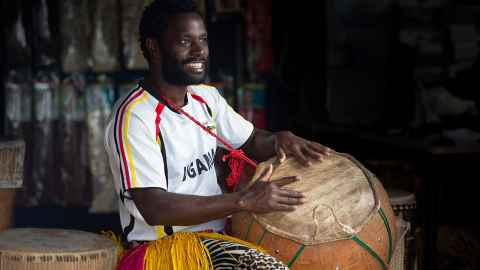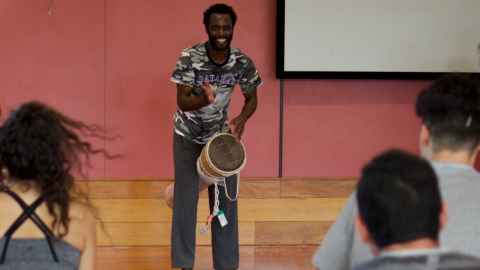Teaching East African dance on Zoom, from a West Auckland living room
26 May 2020
Dr Alfdaniels Mivule Basibye Mabingo is widely recognised as Uganda’s foremost dance educator, critic and choreographer, but has been teaching dance East African-style from his living room in West Auckland.

Dr Mabingo took on his role as lecturer at the University of Auckland’s Dance Studies Programme this year, a few weeks before the country went into lockdown.
It was a coming home of sorts. Having done his undergraduate and masters degrees in dance at Makerere University, Uganda, a second masters degree in dance education at New York University, he completed his PhD at the University of Auckland in 2018.
Having choreographed, taught and danced around the world, teaching remotely from his lounge-room has presented particular challenges. As he notes, dance is something we learn about by doing, usually with other people. “When you’re there in studio, you’re using all your senses; sight, touch, sound, smell. This deepens the connections. You don’t use all those senses on Zoom. It feels like each student is in their own world. The lack of embodied connection makes it difficult.”
There have been plus sides though; he’s paying more attention to technique, both his own and his students in “super-duper detail”, and has “discovered more about the technique of the dances that I’ve been teaching for years and years”.
Dr Mabingo says he can’t remember when he started to dance. “I come from a big family and a community where dance is part of our day-to-day life.”
People are gradually embracing the value of dance as a tool of empowerment ... as a medium of expression of marginalised voices, to enhance physical, emotional, spiritual, mental wellbeing, to add value to people’s lives

He teaches his students the indigenous dances of Uganda, but it’s not only about the technique or the moves; the dances provide a framework for teaching his students how to understand the meanings of dance, the historical, experiential, cultural and social heritage of dance, which can be applied to the wider studies, research and practices in dance and culture.
As people increasingly recognise, dance isn’t the preserve of professional performers. “People are gradually embracing the value of dance as a tool of empowerment, a vehicle that can be used to raise awareness, as a medium of expression of marginalised voices, to enhance physical, emotional, spiritual, mental wellbeing, to add value to people’s lives.”
Teaching dances from African cultures is a way of showing students how to understand the complexities of the dances, in all their idiosyncrasies. “That requires in-depth unpacking of the dance, looking at the movement, the body posture, the attitude of the dancer, their emotional expression, how the dancer’s movement responds to music. So you have to understand the context in which a dance is performed, the functionalities of the dance, how it intersects with people, society and history, the values it represents.
“This is why I left my country. I wanted to share the art and culture of Africa with a wider world, one that often thinks of Africa as a single country, a place with one single story.”
Teaching and learning dances that are co-opted from other cultures can create dilemmas for students that relate to ‘cultural appropriation’. However; “For our dances, it is not appropriation if the original source of that material is acknowledged. I tell students, ‘I’m teaching you this, but if you teach it somewhere, never claim a moral latitude that you represent that community. Acknowledge the source of the dance material and understand the ideas and meanings behind it.”
“But we borrow from each other. We’re human, we’re all products of the intersection of different histories and experiences. So I think it’s fair to acknowledge what you have learned from somewhere else in this world of constant cultural flux and exchanges.”
How does he marry that which he learned growing up in his ancestral village, Mbuukiro, in central Uganda, to that which he teaches (in usual circumstances) at a university in central Auckland? “This is something I’m constantly researching, how to combine my pedagogy with the dances I grew up with”.
“But while I can’t bring my village into the studio, I can cultivate the experience of my village. I’ll bring my drums, and my instruments, and I’ll get the students to tell stories, sing, chant, clap, do body percussion, dance, and create a sense of ritual. That helps students feel and understand what dancing means for people in my village.”
The value of dance in education is highlighted in UNESCO’S International Arts Education week (May 26 to 31) which aims to raise international community’s awareness of the importance of arts education in promoting cultural diversity, intercultural dialogue and social cohesion, to use creativity for a better future. The World Alliance For Arts Education (WAAE) website can be accessed here.
Media contact
Margo White I Media adviser
DDI 09 923 5504
Mob 021 926 408
Email margo.white@auckland.ac.nz